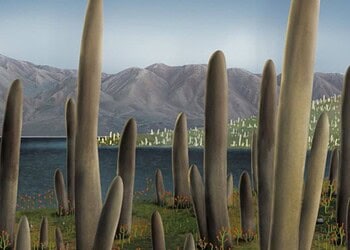
At first glance, this tree almost seems like it fell victim to graffiti vandalism. But if you look closer, you’ll see that it hasn’t been spray painted — the tree is colored like this naturally.
Eucalyptus deglupta is a tall tree, commonly known as the rainbow eucalyptus, Mindanao gum, or rainbow gum. It’s the only eucalyptus tree that naturally grows in the Northern Hemisphere. The rainbow eucalyptus is native to the Philippines, Indonesia, and Papua New Guinea, where it thrives in tropical forests with high rainfall and humid conditions. In its native environment, this tree can grow to impressive heights, sometimes exceeding 200 feet (around 61 meters).
Without a doubt, its most interesting feature is its bark. The bark, splashed with hues of green, blue, purple, orange, and maroon, makes it look like a tree from a painter’s vivid imagination rather than a product of nature. But this is very much natural.

The science behind the rainbow eucalyptus bark
The tree sheds its bark in strips throughout the year. At first, it reveals a bright green inner layer. As this layer is exposed to the air, it begins to age and undergoes a process of chlorophyll breakdown and tannin accumulation, leading to a progression of colors.
Initially, the bark is a vibrant green, which then changes to blue, followed by purple, orange, and finally maroon, before the bark peels away and the cycle begins anew.
This process is influenced by a variety of factors, including the age of the tree, its growth rate, and environmental conditions such as temperature and humidity. The result is a tree trunk that appears to be painted with broad strokes of color.

An important colored tree
You may have already used a product made with rainbow eucalyptus tree: paper. The tree is commonly grown for pulp in some areas.
In the Philippines and other regions where it is native, the wood is commonly used in building materials and as a source of firewood. The tree’s fast growth and adaptability also make it a valuable resource for reforestation projects, helping to restore degraded lands and prevent soil erosion.
Of course, due to its stunning colorful bark, it’s also often grown as a decorative tree. It is planted in parks, gardens, and along streets in tropical and subtropical regions around the world, where it sometimes serves as a popular attraction for its unique appearance.

Where can you see rainbow eucalyptus and can you grow them?
You can see rainbow eucalyptus trees in their native habitats of the Philippines, Indonesia, and Papua New Guinea, where they thrive in tropical forests. Outside of their natural range, these trees have been planted in various parts of the world with suitable climates.
In the United States, they are commonly found in Hawaii, particularly on the islands of Maui and Oahu, where they are popular tourist attractions. Additionally, you can see them in parts of Florida and Southern California, where they are grown as ornamental trees in botanical gardens, parks, and along streets, adding vibrant color to the landscape. In Europe, they are much rarer but some botanical gardens feature them.
If you really want to, you can even grow your own by buying seeds online. However, you should first ensure that the tree can grow in your soil and climate. Also, eucalyptus roots tend to spread a lot, so make sure they won’t cause any damage to property.
The rainbow eucalyptus tree is not currently considered endangered, but it faces significant threats from habitat loss due to deforestation in its native regions of Southeast Asia, where logging and agricultural expansion are leading to the destruction of tropical forests. Climate change also poses a risk, as changes in temperature and rainfall could impact the tree’s growth and survival. Conservation efforts are focused on protecting and restoring its natural habitat through the creation of protected areas, promoting sustainable forestry practices, and implementing reforestation projects to ensure the long-term survival of this remarkable species.







